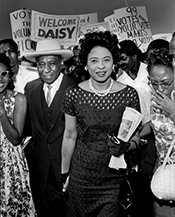|
Review of Passionate Politics: The Life and Times of Charlotte Bunch An Interview with Sharon La Cruise Review of Daisy Bates: First Lady of Little Rock |
||||
 |
||||
Daisy Bates in Memphis, 1958. Image courtesy of The Commercial Appeal. |
||||
Journal Issue 4.2
Daisy Bates: First Lady of Little Rock. 78 minutes. Sakkara Films and the Independent Television Service. 2012.
Review by Zoë Burkholder
The photographs of fifteen-year-old Elizabeth Eckford being turned away from Central High in Little Rock on the first day of school in 1957 are among the most iconic of the black civil rights movement. Part of what makes civil rights history so compelling is its clear moral imperative, and nothing illustrates the evils of racism better than armed white soldiers physically rebuffing a black girl, her arms full of school books, wearing her best new dress on the first day of school.
The desegregation of Little Rock, Arkansas, is part of the established cannon of civil rights history; however, until recently scholars have interpreted this event as a showdown between state and federal law. In contrast, recent scholarship has focused instead on the role of Daisy Bates, the president of the Arkansas chapter of the National Association for the Advancement of Colored People (NAACP) who represented the black community during this crisis. Today, historians are asking new questions about the role of women in the civil rights movement, most of whom were denied leadership positions within major organizations. This film joins a body of new scholarship that seeks to recover the voices and actions of black female activists in the long struggle for civil rights. 1
In the beginning of Daisy Bates: First Lady of Little Rock, filmmaker Sharon La Cruise wonders aloud why she had never heard of Bates, who single-handedly coordinated one of the most infamous school desegregation episodes in American history. This question serves as an intriguing jumping off point for the film, which traces La Cruise's seven year effort to uncover the remarkable history of a key female leader in the black civil rights movement.
The film opens with television footage of the desegregation of Central High School, an event that was scarred by the violent opposition of furious whites to the arrival of nine black children to a previously "white" school. The event deteriorated into a standoff between Arkansas Governor Orval Faubus, who called in the National Guard to stop the black children from attending Central High, and President Dwight D. Eisenhower, who called in the US Army to make sure they could. Bates was in the middle of this battle, working behind the scenes to ensure that school desegregation moved forward and that the nine children continued to attend school for the entire year.
While most historical narratives mention Bates only in passing, La Cruise centers her analysis on Bates as a rare example of a black woman who rose to prominence in the civil rights movement. Viewers are introduced to Bates through footage of her speaking alongside Martin Luther King, Jr., laughing with reporters, challenging the white power structure of Birmingham in front of the shattered front window of her own home. "She was not soft spoken, she was not humble, she didn't ask--she told, it just blew people's minds," says one off-camera commentator. "Daisy Bates was a rabble-rouser, she was pointing her fingers at people, she was organizing boycotts… and people feared her," adds another.
La Cruise does a nice job contextualizing these comments, which have a particular significance when used to describe a black woman in 1950s America. One of the hardest things about teaching civil rights history is trying to get students to fully understand the social and cultural context of the Jim Crow South. Students today, for example, find it rather unremarkable that a woman should be an outspoken leader in anything. What is more, they tend to conflate different time periods such as grainy old television footage of Bates' cutting criticism of the white power structure in 1957 with that of a later generation of female black activists like Angela Davis in the 1970s. This is where a film can be a particularly effective teaching tool that allows students to bear witness to the cultural norms of another time and place.
1 Grif Stockley, Daisy Bates: Civil Rights Crusader from Arkansas (Jackson, MS: University of Mississippi Press, 2012); Davis W. Houck and David E. Dixon, eds., Women and the Civil Rights Movement, 1954-1965 (Jackson, MS: University of Mississippi Press, 2011); Danielle McGuire, At the Dark End of the Street: Black Women, Rape, and Resistance--A New History of the Civil Rights Movement from Rosa Parks to the Rise of Black Power (New York: Vintage Press, 2011); Barbara Ransby, Ella Baker and the Black Freedom Movement: A Radical Democratic Vision (Chapel Hill: University of North Carolina Press, 2005).
Copyright © 2014. All rights reserved.